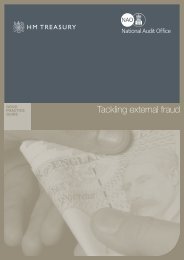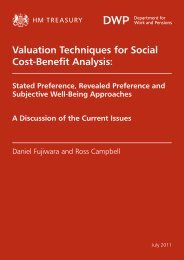4. First case study – the subdivision of the light - HM Treasury
4. First case study – the subdivision of the light - HM Treasury
4. First case study – the subdivision of the light - HM Treasury
Create successful ePaper yourself
Turn your PDF publications into a flip-book with our unique Google optimized e-Paper software.
F05 Ch4 Subdivision <strong>of</strong> <strong>the</strong> <strong>light</strong>.doc<br />
05/04/2006 19:34:00<br />
Technological roulette <strong>–</strong> a multi-disciplinary <strong>study</strong> <strong>of</strong> <strong>the</strong> dynamics <strong>of</strong> innovation in electrical, electronic<br />
and communications engineering.<br />
<strong>4.</strong> <strong>First</strong> <strong>case</strong> <strong>study</strong> <strong>–</strong> <strong>the</strong> <strong>subdivision</strong> <strong>of</strong> <strong>the</strong> <strong>light</strong><br />
means <strong>of</strong> which he obtained some approach to constancy <strong>of</strong> <strong>the</strong> arc <strong>light</strong>, produced<br />
between rods <strong>of</strong> carbon, and he had employed a member <strong>of</strong> <strong>the</strong> Carland family (a well-<br />
known Sunderland family <strong>of</strong> clock- and watch-makers) to construct his lamp.<br />
These lectures exerted a strong influence on <strong>the</strong> youthful Swan who left a<br />
Swan 1929, p23<br />
fragmentary record <strong>of</strong> <strong>the</strong>m.<br />
“ I heard him lecture several times at Sunderland, and saw all his apparatus. I also heard<br />
him, in later years, lecture at Newcastle and Carlisle. I remember that in addition to showing<br />
his lamp, which it was <strong>the</strong> principal object <strong>of</strong> his lecture to exhibit and which he proposed<br />
should be utilised immediately for <strong>light</strong>house purposes, he also on one occasion, in <strong>the</strong><br />
A<strong>the</strong>naeum at Sunderland, illustrated <strong>the</strong> principle <strong>of</strong> electric <strong>light</strong>ing by means <strong>of</strong> a piece <strong>of</strong><br />
iridio-platinum wire. Besides this, I saw this principle very well illustrated at Richardson’s<br />
lectures at <strong>the</strong> same place. This arrested my attention and led me to ponder <strong>the</strong> question, even<br />
at this early period, how to produce electric <strong>light</strong> on this principle, but so as to avoid <strong>the</strong> use <strong>of</strong><br />
a fusible wire. It was something like a seed sown in my mind, which germinated.”<br />
“During <strong>the</strong>se three years all my spare time was spent in chemical and electrical<br />
experiments, carried out for <strong>the</strong> most part by means <strong>of</strong> home-made apparatus and appliances. I<br />
do not know whe<strong>the</strong>r it is a general experience or happy chance helping me, but somehow I<br />
have always been able to utilise, in my experimental work, things that happened to be well<br />
within my reach and that seemed to <strong>of</strong>fer <strong>the</strong>mselves to me.”<br />
Swan was <strong>of</strong>ten stimulated by chance encounters. One day a wood turner, who had<br />
a workshop in <strong>the</strong> neighbourhood, came into Swan’s shop to purchase some copper<br />
sulphate and showed him an electrotype <strong>of</strong> a medallion <strong>of</strong> Napoleon which he had made.<br />
On hearing an explanation <strong>of</strong> how <strong>the</strong> process was carried out, Swan was filled with<br />
enthusiasm and started to experiment with voltaic cells which had recentlybeen developed<br />
by a variety <strong>of</strong> inventors.<br />
Similarly, a serendipitous sight <strong>of</strong> a daguerreotype portrait in an engraver’s window<br />
led to <strong>the</strong> pursuit <strong>of</strong> interests in <strong>the</strong> field <strong>of</strong> photography. Swan was not content merely to<br />
follow <strong>the</strong> lead <strong>of</strong> o<strong>the</strong>rs, but made substantial contributions to <strong>the</strong> developing arts.<br />
Mawson allowed Swan freedom to pursue his interests. Swan rapidly established<br />
himself as a consultant in scientific subjects such as photography and, through contacts<br />
with chemical manufacturers who required technical advice, gradually expanded <strong>the</strong><br />
business activities <strong>of</strong> <strong>the</strong> firm.<br />
At Newcastle Swan struck up friendships with young men <strong>of</strong> similar interests. They<br />
met regularly and engaged in debates on scientific questions. The subjects discussed at<br />
<strong>the</strong>ir meetings were chiefly connected with <strong>the</strong> chemical work which was incidental to<br />
<strong>the</strong>ir employment. On holidays <strong>the</strong>y would visit chemical works toge<strong>the</strong>r. In his leisure<br />
93





![AIRTO [Professor Dr Brian Blunden] - HM Treasury](https://img.yumpu.com/15492848/1/184x260/airto-professor-dr-brian-blunden-hm-treasury.jpg?quality=85)










